Opinion & Analysis
Callaway R&D Director on the XR irons, 360 Face Cup
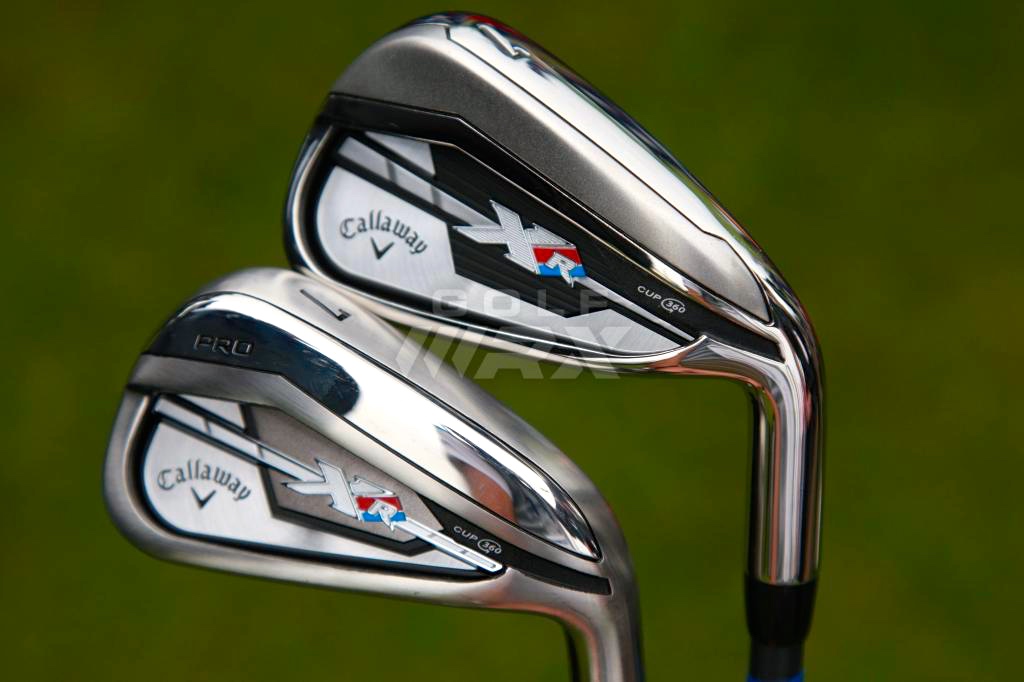
Scott Manwaring, Callaway’s director of R&D for irons, hybrids and wedges, has been with the company for nearly two decades, and he’s worked in club design since the mid-2000s. He’s seen a lot in his time at the Carlsbad-based company, which under the direction of CEO Chip Brewer, is putting product front-and-center, according to the R&D specialist.
The company’s latest product to stand front and center: Callaway’s XR and XR Pro irons with Callaway’s Face Cup 360 technology.
Manwaring, who graduated from Brigham Young University with a degree in mechanical engineering, said he was incredibly proud of the new XR and XR Pro irons, which were the focus of our conversation.
Note: Topics in bold with Manwaring’s replies beneath
Callaway’s primary focus, how it influences product
The broad umbrella changed with Chip coming here. He said, “Be proud of the product that you’re creating.” Before, it was a lot more nuanced and complicated.
Chip is driven on the product front. Callaway spends more than $30 million per year in R&D, so that philosophy comes from Chip himself: Be proud of it. Drive every last detail, do it as quickly as possible.
That has to drive its way into every category. With the X Hot fairway wood, we took it all the way to the finish line. The next year, we said, “Let’s get the hybrids.” This was the first year that that mantra really hit irons. I obviously had a lot going on, and we’re trying to change a lot of products, but you can only turn a boat so fast; this is the first year we said, “Let’s really drive it home in irons.”
Developing the XR Irons
On the Apex iron, where your COGs are a lot higher, it’s easier to fix that one. When you get down to the $799 category, you have to think a lot harder about every nickel you spend and why you spend it to give the consumer the best value and also make a product you’re proud of. That just takes a little more time and effort.
Just to give you a perspective of what a pain in the a** this iron was to make: We did eight prototyping iterations with the suppliers alone — You know, get the part back, test it, change it. That is at least five or six more than we would normally do. That doesn’t even count internally. We did about four or five…using our own machines.
Addressing concerns about hot spots
We were aware of the complaint. From our position, a common complaint is just an opportunity to do something completely different and completely out of the box.
You have this opportunity with Chip coming on board and saying, “Do something different…do something that you’re proud of. Do something that’s harder.”
You have this great opportunity to break the problem up and really dig into every detail…and think in different ways to tackle all those items.
An overview of Cup 360 technology
Talking about the 360 cup face: By separating an iron into two pieces, you inherently increase the complexity and the cost. And when you weld two similar materials, it’s kind of counter-intuitive. But we needed to cast the face independently because we needed control of every…point on the back of the face.
We needed to control the thickness at every location to avoid changes in thickness that create hotspots.
You’re seeing a lot of companies take the easier solution and not keep the CG in the optimal spot, because they know they need to control face. And you see them taking the simple solution and not worrying about the thickness.
You’re still using the same FEA tools and all the stuff you’ve used in the past, but when you do things like this…when you’re trying to get the distance, plus maintain consistency, your material properties become way more critical. So all your analysis tools start to struggle. You pick up failure modes that are somewhat unexpected.
I think one aspect that’s kind of lost on everybody here is when we did the face cups on the fairway woods and the hybrids, you had this eggshell principle going on where it was a closed-back system…it was naturally stronger and thicker.
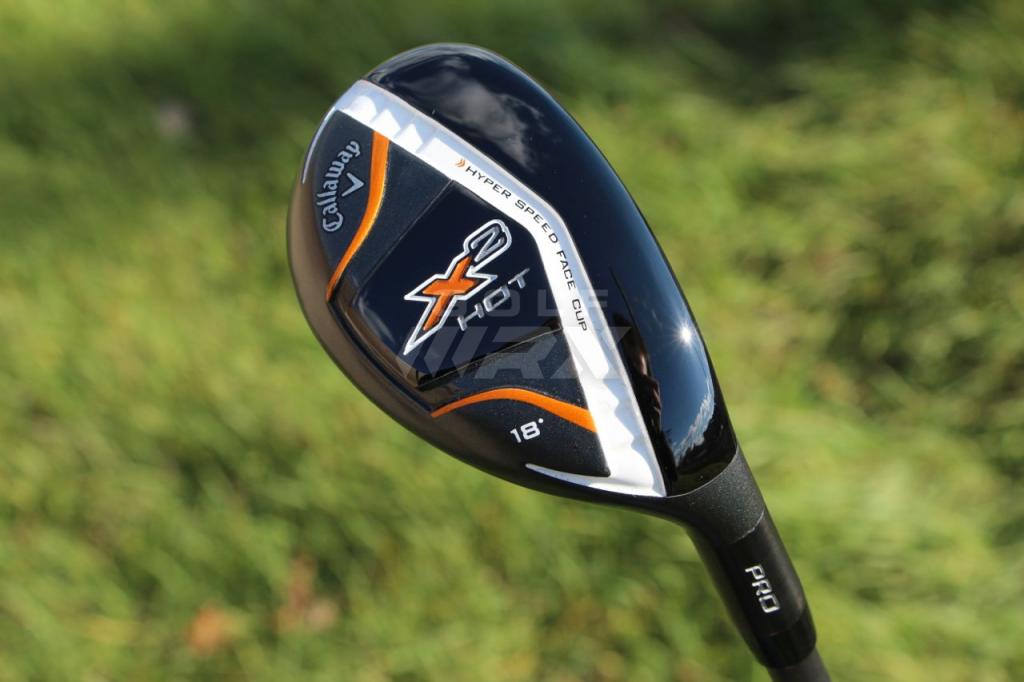
Callaway’s X2 Hot and X2 Hot Hybrids (2014) brought the company’s face cup technology to hybrids, giving them the 455 carpenter steel faces used on the 2013 X Hot fairway woods.
On a cavity back iron, when you open up the back of that iron, you’re now on a way more flexible system. Dealing with your durability requirements and your strength requirements is a lot more complicated. And when you overlay the cost…you’ve got a real problem.
The face cup, it’s just as critical as the body. When you separate the face cup…it allows you to minimize your hotspots, especially when you cast it, because then you don’t have any machining marks, you’re not dealing with forging or some of the inherent problems that come there with draft analysis and some of the complexity there…and the cost.
The COR testing becomes obvious. You put that cup face on there and your COR gains across the face are just incredible. So the face cup is critical, but then you’ve got to move to the body. The second you…pull the mass away from the face…your center of gravity just climbs immediately…and then you’ve washed out all the gains. So, step two is finding a body design that when all that energy is transferred off the face, it doesn’t die.
The XR Pro
On the Pro, we wanted to not offend PGA Tour players with the thicker top line. Getting that just right—where it still has the durability and still has the ball speed and still has the COR numbers we were interested in, and it still has the CG and can carry the load—it was a challenge.
Your thickness on that top line: As you get that face to transfer energy more efficiently to the ball and ultimately also to the body…it becomes a trampoline. And if you wanted the metal rims around the trampoline to be thinner, the person jumping on it is still transferring the same load, and if you start thinning those rims down too much, they just give out.
So, the Pro iron is an incredible club…some better players hit the Pro farther than they do the standard [XR]. When I was looking at the COR data, I originally thought it was just the offset and they were able to swing at it more aggressively. But…we did a damn good job…it’s incredibly efficient for its face area.
A walkthrough of Callaway’s 2015 irons
With Big Bertha, it’s just “how can we help you?” We’re doing everything we can to help you enjoy the round of golf. We’re going to help you get the ball to fly far. You’re going to have a lot of hybrids in your bag.
With the XR, we intentionally designed stuff in there to help the average golfer that we knew the better player would snub their nose at. But with the XR Pro, Chip said: “You’re not allowed to skimp on the technology.”
In creating the XR Pro, we took everything we learned from the XR—because we did that first—and applied those lessons to the XR Pro in a shape that we knew wouldn’t offend, and it ended up doing really, really well.
The XR is for the center-of-the-green player. The player who isn’t going to work the ball, who just wants to check the yardage and hit it. But in order to help that player along, it requires a certain offset, a certain top line thickness, a sole width to help with turf interaction, a little more MOI. The XR is for that weekend guy that’s out there quite a bit.
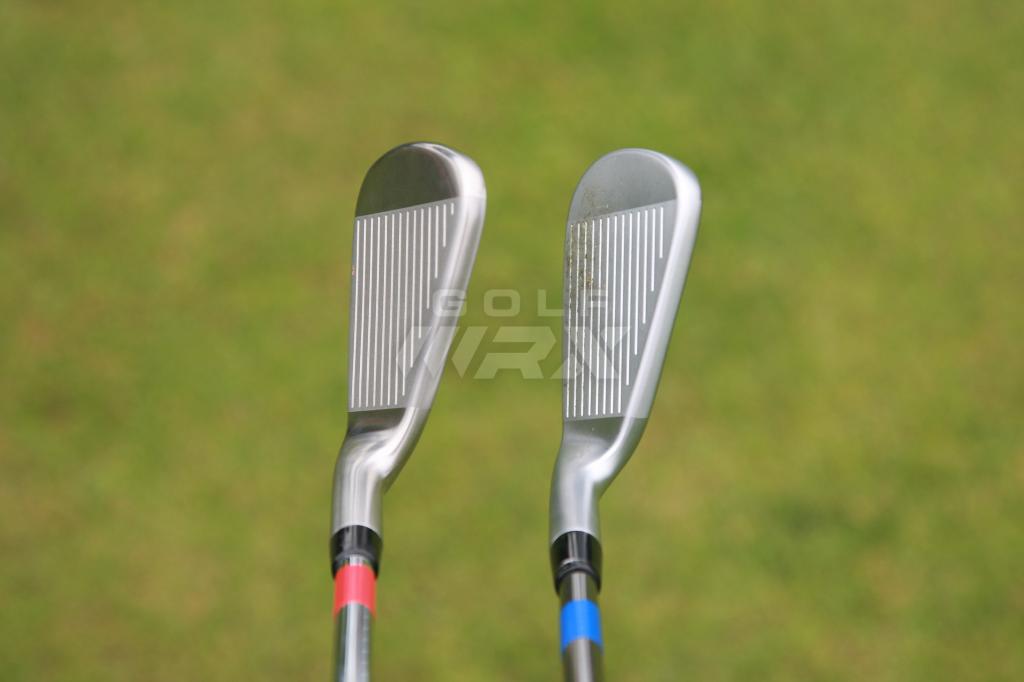
At Address: Callaway’s XR Pro (left) and Apex irons.
The XR Pro…was really going after someone who really likes his Apex irons but would like a little more control. We kind of kept the offset; we narrowed the top line back down. We brought the sole width back down…and this is a guy we see wanting to be a pin-seeker, wanting to really go after it…he’s going to be disappointed if he didn’t pull the shot off. So the MOI is a little lower, the top line is a little thinner. The Pro is for someone who I think is truly passionate about their game.
- LIKE112
- LEGIT10
- WOW9
- LOL4
- IDHT6
- FLOP10
- OB7
- SHANK14
Opinion & Analysis
The Wedge Guy: What really makes a wedge work? Part 1

Of all the clubs in our bags, wedges are almost always the simplest in construction and, therefore, the easiest to analyze what might make one work differently from another if you know what to look for.
Wedges are a lot less mysterious than drivers, of course, as the major brands are working with a lot of “pixie dust” inside these modern marvels. That’s carrying over more to irons now, with so many new models featuring internal multi-material technologies, and almost all of them having a “badge” or insert in the back to allow more complex graphics while hiding the actual distribution of mass.
But when it comes to wedges, most on the market today are still single pieces of molded steel, either cast or forged into that shape. So, if you look closely at where the mass is distributed, it’s pretty clear how that wedge is going to perform.
To start, because of their wider soles, the majority of the mass of almost any wedge is along the bottom third of the clubhead. So, the best wedge shots are always those hit between the 2nd and 5th grooves so that more mass is directly behind that impact. Elite tour professionals practice incessantly to learn to do that consistently, wearing out a spot about the size of a penny right there. If impact moves higher than that, the face is dramatically thinner, so smash factor is compromised significantly, which reduces the overall distance the ball will fly.
Every one of us, tour players included, knows that maddening shot that we feel a bit high on the face and it doesn’t go anywhere, it’s not your fault.
If your wedges show a wear pattern the size of a silver dollar, and centered above the 3rd or 4th groove, you are not getting anywhere near the same performance from shot to shot. Robot testing proves impact even two to three grooves higher in the face can cause distance loss of up to 35 to 55 feet with modern ‘tour design’ wedges.
In addition, as impact moves above the center of mass, the golf club principle of gear effect causes the ball to fly higher with less spin. Think of modern drivers for a minute. The “holy grail” of driving is high launch and low spin, and the driver engineers are pulling out all stops to get the mass as low in the clubhead as possible to optimize this combination.
Where is all the mass in your wedges? Low. So, disregarding the higher lofts, wedges “want” to launch the ball high with low spin – exactly the opposite of what good wedge play requires penetrating ball flight with high spin.
While almost all major brand wedges have begun putting a tiny bit more thickness in the top portion of the clubhead, conventional and modern ‘tour design’ wedges perform pretty much like they always have. Elite players learn to hit those crisp, spinny penetrating wedge shots by spending lots of practice time learning to consistently make contact low in the face.
So, what about grooves and face texture?
Grooves on any club can only do so much, and no one has any material advantage here. The USGA tightly defines what we manufacturers can do with grooves and face texture, and modern manufacturing techniques allow all of us to push those limits ever closer. And we all do. End of story.
Then there’s the topic of bounce and grinds, the most complex and confusing part of the wedge formula. Many top brands offer a complex array of sole configurations, all of them admittedly specialized to a particular kind of lie or turf conditions, and/or a particular divot pattern.
But if you don’t play the same turf all the time, and make the same size divot on every swing, how would you ever figure this out?
The only way is to take any wedge you are considering and play it a few rounds, hitting all the shots you face and observing the results. There’s simply no other way.
So, hopefully this will inspire a lively conversation in our comments section, and I’ll chime in to answer any questions you might have.
And next week, I’ll dive into the rest of the wedge formula. Yes, shafts, grips and specifications are essential, too.
- LIKE17
- LEGIT6
- WOW1
- LOL1
- IDHT2
- FLOP2
- OB1
- SHANK1
Golf's Perfect Imperfections
Golf’s Perfect Imperfections: Amazing Session with Performance Coach Savannah Meyer-Clement

In this week’s episode, we spent some time with performance coach Savannah Meyer-Clement who provides many useful insights that you’ll be able to implement on the golf course.
- LIKE0
- LEGIT0
- WOW0
- LOL0
- IDHT0
- FLOP0
- OB0
- SHANK0
19th Hole
Vincenzi’s 2024 RBC Heritage betting preview: Patrick Cantlay ready to get back inside winner’s circle

Just a two-hour drive from Augusta National, the PGA TOUR heads to Harbour Town Golf Links in Hilton Head Island, S.C. Hilton Head Island is a golfer’s paradise and Harbour Town is one of the most beautiful and scenic courses on the PGA TOUR.
Harbour Town Golf Links is a par-71 that measures 7,121 yards and features Bermuda grass greens. A Pete Dye design, the course is heavily tree lined and features small greens and many dog legs, protecting it from “bomb-and-gauge” type golfers.
The field is loaded this week with 69 golfers with no cut. Last year was quite possibly the best field in RBC Heritage history and the event this week is yet another designated event, meaning there is a $20 million prize pool.
Most of the big names on the PGA Tour will be in attendance this week with the exceptions of Hideki Matsuyama and Viktor Hovland. Additionally, Webb Simpson, Shane Lowry, Gary Woodland and Kevin Kisner have been granted sponsors exemptions.
Past Winners at Harbour Town
- 2023: Matt Fitzpatrick (-17)
- 2022: Jordan Spieth (-13)
- 2021: Stewart Cink (-19)
- 2020: Webb Simpson (-22)
- 2019: CT Pan (-12)
- 2018: Sotoshi Kodaira (-12)
- 2017: Wesley Bryan (-13)
- 2016: Branden Grace (-9)
- 2015: Jim Furyk (-18)
In this article and going forward, I’ll be using the Rabbit Hole by Betsperts Golf data engine to develop my custom model. If you want to build your own model or check out all of the detailed stats, you can sign up using promo code: MATTVIN for 25% off any subscription package (yearly is best value).
Key Stats For Harbour Town
Let’s take a look at key metrics for Harbour Town Golf Links to determine which golfers boast top marks in each category over their past 24 rounds.
Strokes Gained: Approach
Strokes Gained: Approach is exceedingly important this week. The greens at Harbour Town are about half the size of PGA TOUR average and feature the second-smallest greens on the tour. Typical of a Pete Dye design, golfers will pay the price for missed greens.
Total SG: Approach Over Past 24 Rounds
- Scottie Scheffler (+1.27)
- Tom Hoge (+1.27)
- Corey Conners (+1.16)
- Austin Eckroat (+0.95)
- Cameron Young (+0.93)
Good Drive %
The fairways at Harbour Town are tree lined and feature many dog legs. Bombers tend to struggle at the course because it forces layups and doesn’t allow long drivers to overpower it. Accuracy is far more important than power.
Good Drive % Over Past 24 Rounds
- Brice Garnett (88.8%)
- Shane Lowry (+87.2%)
- Akshay Bhatia (+86.0%)
- Si Woo Kim (+85.8%)
- Sepp Straka (+85.1%)
Strokes Gained: Total at Pete Dye Designs
Pete Dye specialists tend to play very well at Harbour Town. Si Woo Kim, Matt Kuchar, Jim Furyk and Webb Simpson are all Pete Dye specialists who have had great success here. It is likely we see some more specialists near the top of the leaderboard this week.
SG: TOT Pete Dye per round over past 36 rounds:
- Xander Schauffele (+2.27)
- Scottie Scheffler (+2.24)
- Ludvig Aberg (+2.11)
- Brian Harman (+1.89)
- Sungjae Im (+1.58)
4. Strokes Gained: Short Game (Bermuda)
Strokes Gained: Short Game factors in both around the green and putting. With many green-side bunkers and tricky green complexes, both statistics will be important. Past winners — such as Jim Furyk, Wes Bryan and Webb Simpson — highlight how crucial the short game skill set is around Harbour Town.
SG: SG Over Past 24 Rounds
- Jordan Spieth (+1.11)
- Taylor Moore (+1.02)
- Wyndham Clark (+0.98)
- Mackenzie Hughes (+0.86)
- Andrew Putnam (+0.83)
5. Greens in Regulation %
The recipe for success at Harbour Town Golf Links is hitting fairways and greens. Missing either will prove to be consequential — golfers must be in total control of the ball to win.
Greens in Regulation % over past 24 rounds:
- Brice Garnett (+75.0%)
- Scottie Scheffler (+69.9%)
- Corey Conners (+69.0%)
- Shane Lowry (+68.3%)
- Patrick Rodgers (+67.6%)
6. Course History
Harbour Town is a course where players who have strong past results at the course always tend to pop up.
Course History over past 24 rounds:
- Patrick Cantlay (+2.34)
- Cam Davis (+2.05)
- J.T. Poston (+1.69)
- Justin Rose (+1.68)
- Tommy Fleetwood (+1.59)
The RBC Heritage Model Rankings
Below, I’ve compiled overall model rankings using a combination of the five key statistical categories previously discussed — SG: Approach (24%), Good Drives (20%), SG: SG (14%), SG: Pete Dye (14%), GIR (14%), and Course History (14%)
- Shane Lowry
- Russell Henley
- Scottie Scheffler
- Xander Schauffele
- Corey Conners
- Wyndham Clark
- Christiaan Bezuidenhout
- Matt Fitzpatrick
- Cameron Young
- Ludvig Aberg
2024 RBC Heritage Picks
Patrick Cantlay +2000 (FanDuel)
With the exception of Scottie Scheffler, the PGA Tour has yet to have any of their star players show peak form during the 2024 season. Last week, Patrick Cantlay, who I believe is a top-5 players on the PGA Tour, took one step closer to regaining the form that’s helped him win eight events on Tour since 2017.
Cantlay limped into the Masters in poor form, but figured it out at Augusta National, finishing in a tie for 20th and ranking 17th for the week in Strokes Gained: Ball Striking. The former FedEx Cup champion will now head to one of his favorite golf courses in Harbour Town, where he’s had immaculate results over the years. In his six trips to the course, he’s only finished worse than 7th one time. The other finishes include three third places (2017, 2019, 2023) and one runner-up finish (2022). In his past 36 rounds at Harbour Town, Cantlay ranks 1st in Strokes Gained: Total per round at the course by a wide margin (+2.36).
Cantlay is winless since the 2022 BMW Championship, which is far too long for a player of his caliber. With signs pointing to the 32-year-old returning to form, a “signature event” at Harbour Town is just what he needs to get back on the winning track.
Tommy Fleetwood +3000 (FanDuel)
I truly believe Tommy Fleetwood will figure out a way to win on American soil in 2024. It’s certainly been a bugaboo for him throughout his career, but he is simply too talented to go another season without winning a PGA Tour event.
At last week’s Masters Tournament, Fleetwood made a Sunday charge and ended up finishing T3 in the event, which was his best ever finish at The Masters. For the week, the Englishman ranked 8th in the field in Strokes Gained: Approach, 10th in Strokes Gained: Ball Striking and 16th in Strokes Gained: Putting.
Harbour Town is a perfect layout for Fleetwood, and he’s had relative success at this Pete Dye design in the past. In his four trips to the course, he’s finished inside of the top 25 three times, with his best finish, T10, coming in 2022. The course is pretty short and can’t be overpowered, which gives an advantage to more accurate players such as Fleetwood. Tommy ranks 8th in the field in Good Drive % and should be able to plot his way along this golf course.
The win is coming for Tommy lad. I believe there’s a chance this treasure of a golf course may be the perfect one for him to finally break through on Tour.
Cameron Young +3300 (FanDuel)
Cameron Young had a solid Masters Tournament last week, which is exactly what I’m looking for in players who I anticipate playing well this week at the RBC Heritage. He finished in a tie for 9th, but never felt the pressure of contending in the event. For the week, Young ranked 6th in Strokes Gained: Off the Tee and 6th in Strokes Gained: Ball Striking.
Despite being one of the longest players off the tee on the PGA Tour, Young has actually played some really good golf on shorter tracks. He finished T3 at Harbour Town in 2023 and ranks 20th in the field in Good Drive% and 16th in Greens in Regulation in his past 24 rounds. He also has strong finishes at other shorter courses that can take driver out of a players hand such as Copperhead and PGA National.
Young is simply one of the best players on the PGA Tour in 2024, and I strongly believe has what it takes to win a PGA Tour event in the very near future.
Corey Conners +5500 (FanDuel)
Corey Conners has had a disappointing year thus far on the PGA Tour, but absolutely loves Harbour Town.
At last week’s Masters Tournament, the Canadian finished T30 but ranked 20th in the field in Strokes Gained: Approach. In his past 24 rounds, Conners ranks 3rd in the field in Strokes Gained: Approach, 3rd in Greens in Regulation % and 24th in Good Drive %.
In Conners’ last four trips to Harbour Town, his worst finish was T31, last season. He finished T4 in 2021, T12 in 2022 and ranks 8th in Strokes Gained: Total at the course over his past 36 rounds.
Conners hasn’t been contending, but his recent finishes have been encouraging as he has finished in the top-25 in each of his past three starts prior to The Masters, including an impressive T13 at The PLAYERS. His recent improvement in ball striking as well as his suitability for Harbour Town makes Conners a high upside bet this week.
Shane Lowry (+7500) (FanDuel)
When these odds were posted after Lowry was announced in the field, I have to admit I was pretty stunned. Despite not offering much win equity on the PGA Tour over the last handful of years, Shane Lowry is still a top caliber player who has the ability to rise to the top of a signature event.
Lowry struggled to score at The Masters last week, but he actually hit the ball really well. The Irishman ranked 1st for Strokes Gained: Approach on the week and 7th in Strokes Gained: Ball Striking. As usual, it was the putter that let him down, as he ranked 60th in the field in Strokes Gained: Putting.
Harbour Town is most definitely one of Lowry’s favorite courses on the PGA Tour. In his six starts there, he’s finished in the top 10 three times, including third twice. Lowry is sensational at Pete Dye designs and ranks 7th in Strokes Gained: Total in his past 36 rounds on Dye tracks.
Lowry is perfect for Harbour Town. In his past 24 rounds, he ranks 5th in Strokes Gained: Approach, 2nd in Good Drive% and 5th in Green in Regulation %. If he figures it out on the greens, Shane could have his first win in America since 2015.
Lucas Glover +12000 (FanDuel)
This is one of my weekly “bet the number” plays as I strongly believe the odds are just too long for a player of Glover’s caliber. The odds have been too long on Glover for a few weeks now, but this is the first event that I can get behind the veteran being able to actually contend at.
Glover is quietly playing good golf and returning to the form he had after the understandable regression after his two massive victories at the end of 2023. He finished T20 at The Masters, which was his best ever finish at Augusta National. For the week, Lucas ranked 18th for Strokes Gained: Approach and 20th in Strokes Gained: Ball Striking.
Over his past 24 rounds, Glover ranks 9th in Strokes Gained: Approach and 13th in Good Drive %. Harbour Town is a short course that the 44-year-old will be able to keep up with the top players on Tour off the tee. He’s played the course more than 20 times, with mixed results. His best finishes at Harbour Town include a T7 in 2008, but recently has a finish of T21 in 2020.
Glover has proven he can contend with the stars of the Tour on any given week, and this number is flat out disrespectful.
- LIKE30
- LEGIT5
- WOW2
- LOL1
- IDHT1
- FLOP2
- OB0
- SHANK2
-

 19th Hole1 week ago
19th Hole1 week agoDave Portnoy places monstrous outright bet for the 2024 Masters
-

 19th Hole3 weeks ago
19th Hole3 weeks agoThings got heated at the Houston Open between Tony Finau and Alejandro Tosti. Here’s why
-

 19th Hole1 week ago
19th Hole1 week agoTiger Woods arrives at 2024 Masters equipped with a putter that may surprise you
-

 19th Hole2 weeks ago
19th Hole2 weeks agoReport: Tiger Woods has ‘eliminated sex’ in preparation for the 2024 Masters
-

 19th Hole5 days ago
19th Hole5 days agoTwo star names reportedly blanked Jon Rahm all week at the Masters
-

 19th Hole4 days ago
19th Hole4 days agoNeal Shipley presser ends in awkward fashion after reporter claims Tiger handed him note on 8th fairway
-

 19th Hole3 days ago
19th Hole3 days agoReport: LIV Golf identifies latest star name they hope to sign to breakaway tour
-

 19th Hole2 weeks ago
19th Hole2 weeks agoAddiction, spinal fusion, and scam artists – Everything Anthony Kim revealed in candid interview with David Feherty

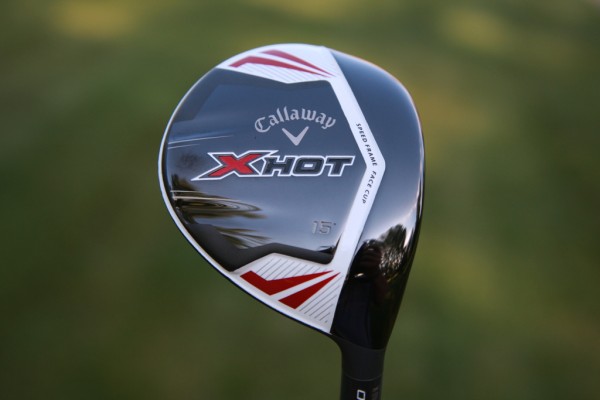
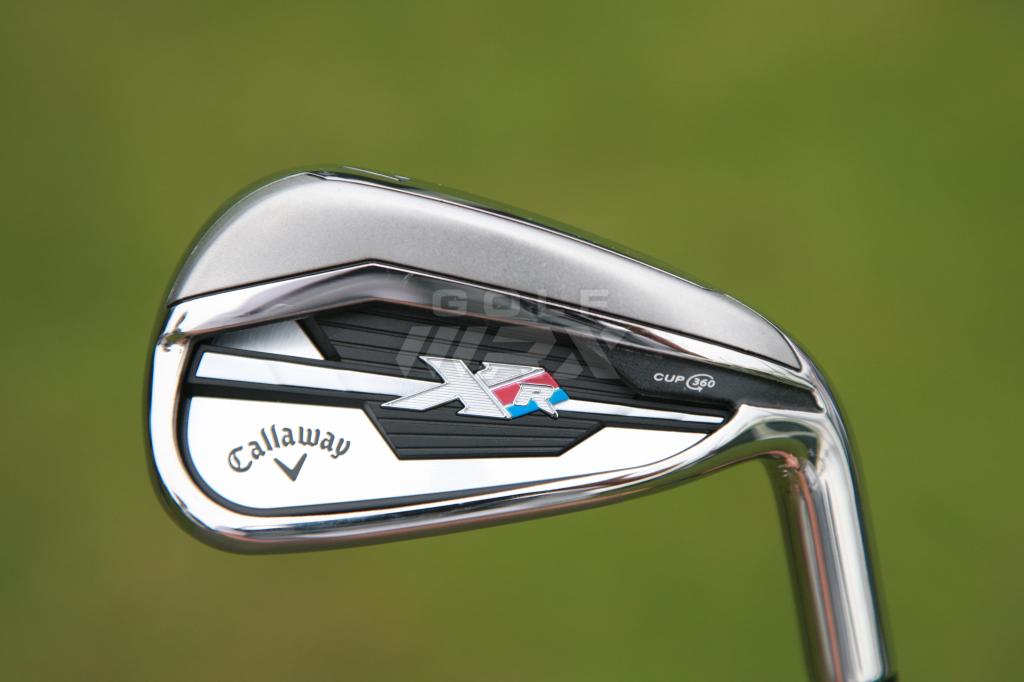
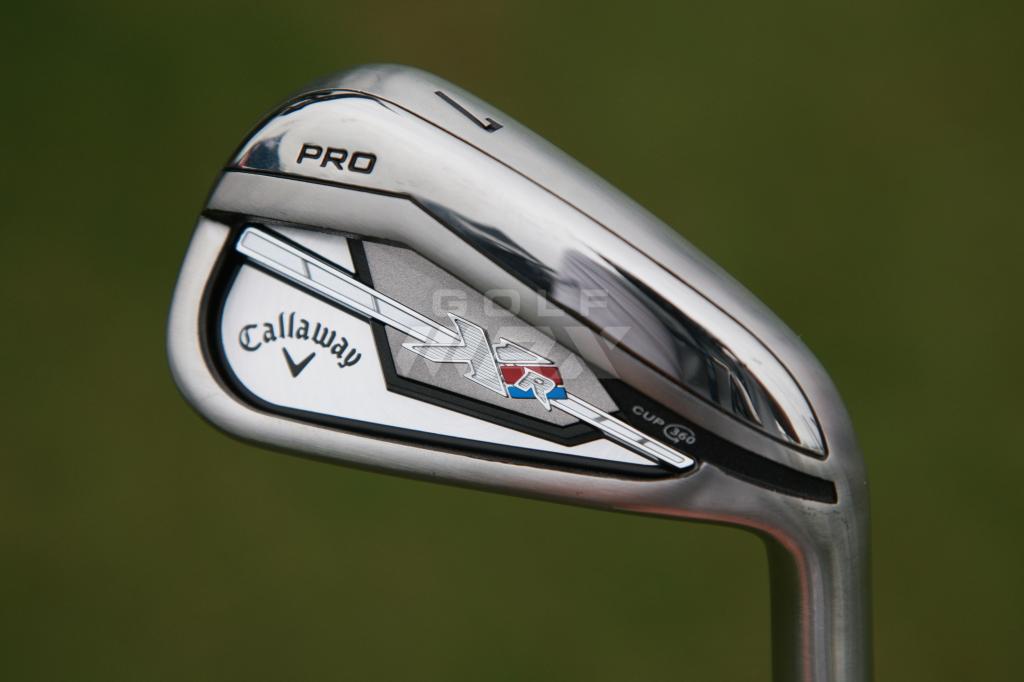
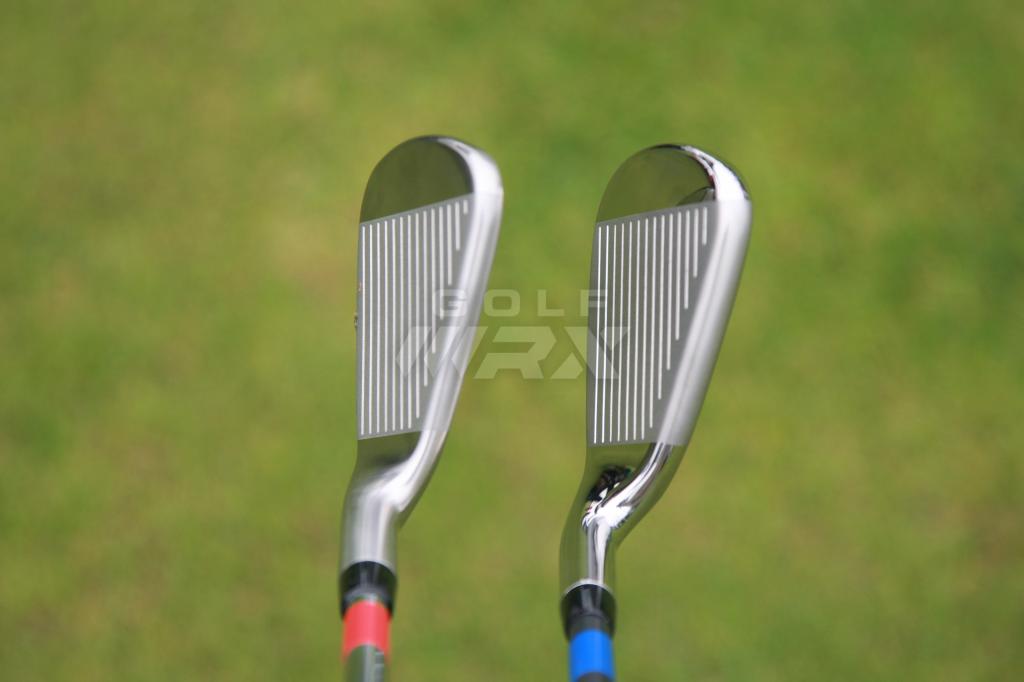
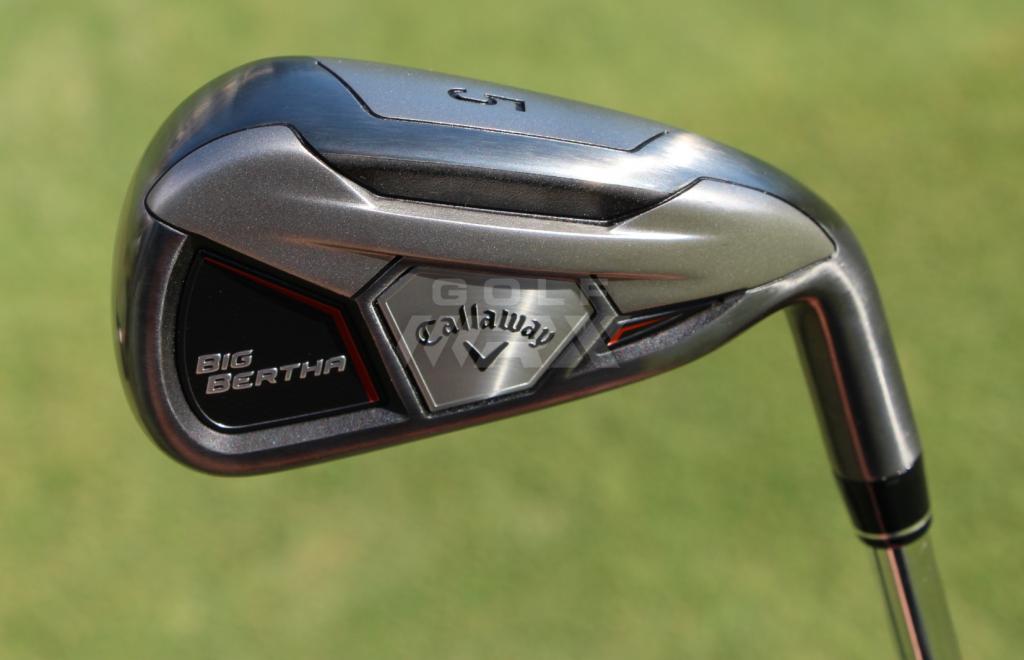















t golf
Mar 3, 2015 at 8:30 am
How much different are these than something like the speedblades? Those have little off set for a GI and pound the ball. Straight too.
Vito
Mar 1, 2015 at 1:19 pm
Just ordered my XR Pro and Apex MB combo set. Now if the snow will just allow me to use them…
Jeff
Feb 24, 2015 at 5:24 pm
Oh great, now I have to throw out my Apex Pros. The marketing on these new iron sets leaves the guys who bought last year’s sales pitch hung out to dry. Basically, last year’s 1200 dollar set is obsolete, because, you know, face cups and stuff. High CT, face cups, progressive this, channel slot that. I hope the garbage man takes my Apex Pros without charging me extra.
killerbgolfer
Feb 24, 2015 at 10:16 pm
I hope not, i just got the Apex forged! I don’t see these really threatening the forged offerings. Until there’s new forged offerings…
Ol deadeye
Feb 25, 2015 at 11:29 am
Well, keeping in mind that the USGA limits the COR of all club faces, I took my 20 yr old daughter(12 handicap) to a big box store. We compared her shots with her Ping G20 seven iron (steel R shaft) and both Taylormade RSi 1 and Callaway XR seven irons. Distance increase? About one or two yards with either club. With both steel or graphite shaft. She preferred the steel shafts. These were 85 grams and Ping steel is about 100. She preferred the impact feel and swing weight of the Taylormade. Enough there to replace her clubs? Not in our opinions.
Ol deadeye
Feb 23, 2015 at 2:04 pm
It would seem that the players most interested in distance with irons would be the better women players. Not granny who retired and took up golf at 65. Younger women who hit an eight iron 110 yards. If the shaft is about the same length but flies the ball ten yards further that would be a game changer.
Roosterredneck
Feb 23, 2015 at 1:12 pm
The 360 club design is not new. Macgregor did this years ago.Yes the thick top line and off set is excessive for me .. Buy a Macgregor model it should be much cheaper.
Teaj
Feb 20, 2015 at 3:37 pm
These things get out there, stronger then your traditional lofts yes but if your looking for a little extra distance with forgiveness and less offset these might fit the bill. They go a little to far for me as I don’t really need to hit my clubs farther but the forgiveness with less offset is something to think about for players not playing as much as they used to but still don’t need offset. Go try it before you knock it, for the right person these would be a great club.
Person
Feb 20, 2015 at 11:52 am
What throws me off about those irons is how round the topline looks from address. Also yes they look just a little too thick for my tastes.
Vincent
Feb 20, 2015 at 10:45 am
Callaway could forget the “Big Bertha” trademark. This is a cannon built and used by the German army against Belgian and French soldiers and fortresses during the First World War. What could we think about a golf club named Kalashnikov?
graymulligan
Feb 22, 2015 at 7:26 pm
If you asked most folks at this point, especially golfers, they would equate the Big Bertha name to the clubs, and not the cannon. It might be a couple decades too late to have this conversation.
gwillis7
Feb 20, 2015 at 10:36 am
Very interesting article. Haven’t had a ton of Callaway gear in the past, but did have the x-hot driver and that thing was a beast. Last couple years they def have made huge strides in woods
Dave S
Feb 20, 2015 at 9:15 am
This probably isn’t the forum to post this, but looking at the top-line pics of these irons, it really struck me. I’ve always struggled with the large off-set that typically exists in a true GI iron. My natural shot shape with irons is right to left, with my miss usually being a hook. I’m not a great player by any stretch (14 hcp) and I’ve been playing the Adams CMBs for three seasons now. I’ve always been a naturally good athlete, but I really don’t play enough to get great at golf (every other weekend in the spring and summer), so I think GI irons could help. BUT, they all have that huge off-set, which with my natural in-to-out swing path, would likely exacerbate my hook. I guess these OEMs have to make a product that fits the majority of mid-high handicappers and their miss is usually left to right… I’m kind of in a weird spot.
Jeff
Feb 24, 2015 at 5:19 pm
Dave, players cavity backs. Less offset, more forgiveness.
CHRIS
Feb 20, 2015 at 8:40 am
Looks like tennis rackets to me, both of them. I just cannot bear to look down and see a topline like that.
Rich
Feb 20, 2015 at 9:11 am
Keep playing your blades mate. I’ll take your money with a set of XR pros thanks.
Mike
Feb 20, 2015 at 9:24 am
Rich you know if you don’t use blades you’re a loser! 🙂 Which I guess I am since I just took delivery of my XR Pros.
Rich
Feb 20, 2015 at 5:14 pm
Yep, I know what you mean Mike. Happy to be a loser. Can’t wait to try the XR pro’s, they look pretty good to me. Happy for all the help I can get these days.
Philip
Feb 20, 2015 at 2:29 pm
Maybe, maybe not – if the guy doesn’t like the look than so what? By the way, I don’t like them too, but whether one plays blades or XR Pros is irrelevant to whether they’ll beat someone else in a match. I’ve played both with players using blades and players using clubs like the XP Pros and the deciding factor of their game has NOTHING to do with what type of iron they play, but whether they know their true yardages and whether they know their weaknesses and play accordingly.
Rich
Feb 20, 2015 at 5:08 pm
Easy there tiger. Just poking a bit of fun. I love blades and have several sets but don’t play them much anymore because my game is not what it used to be. All power to those that can.
XR is King
Feb 19, 2015 at 10:59 pm
The XR irons are going to blow everybody away!!!!! Awesome!!!!
Cyd
Feb 19, 2015 at 10:30 pm
Hit the Pro model further???? Difference in lofts maybe?
Cyd
Feb 19, 2015 at 10:29 pm
Hit the Pro further???? Difference in lofts?
I have a new set of irons for the masses. Guaranteed to add 15 more yards. Of course the lofts are 2* stronger than the previous model so now your 7 Iron is what used to be a 5 iron, the PW is what used to be an 8 iron, so on and so forth.
But by golly I can hit a 8 Iron 190 or more and Hogan or Nicklaus could never do that.
Tom
Feb 20, 2015 at 4:17 pm
Pro is +1* on lofts (weaker) and shorter in length in the long irons (3-6) than the plain XR also lie angles are different between the models.
And yes lofts are stronger than in the 60’s or 70’s but when I can get a 7i launching at over 20* why should I care? As to added length, hey 4 wedges is fine in the bag. (Really only 2 or 3 using old lofts.) So long as my misses are closer in results to solid hits.
BTW: Jack could do that. He choose not to most of the time. I remember him being in trouble at Firestone once and hitting a VERY long 8i. But then that was with far worse equipment esp. balls than today!
Steve
Feb 19, 2015 at 7:33 pm
Xhot line with different colors
LMB
Feb 19, 2015 at 10:24 pm
I’d say that was true for X2 Hot irons but these have legit tech updates.
Tom
Feb 19, 2015 at 7:11 pm
Both the XR and XR Pro swing very nice. (With proper fit.) I get my XR Pro irons next week, my pro e-mailed me they got in and would be available at my lesson on Tue. I’ve been hitting the demo iron and LOVE how it feels/swings, the feed back, and how consistent yardage is between center and off center hits. Callaway was not on my radar when I went to get new irons but these just blew me away! 🙂
LMB
Feb 19, 2015 at 6:36 pm
Sounds like they made the XR first, and then figured out how to make a better version of it when they did the XR Pro…